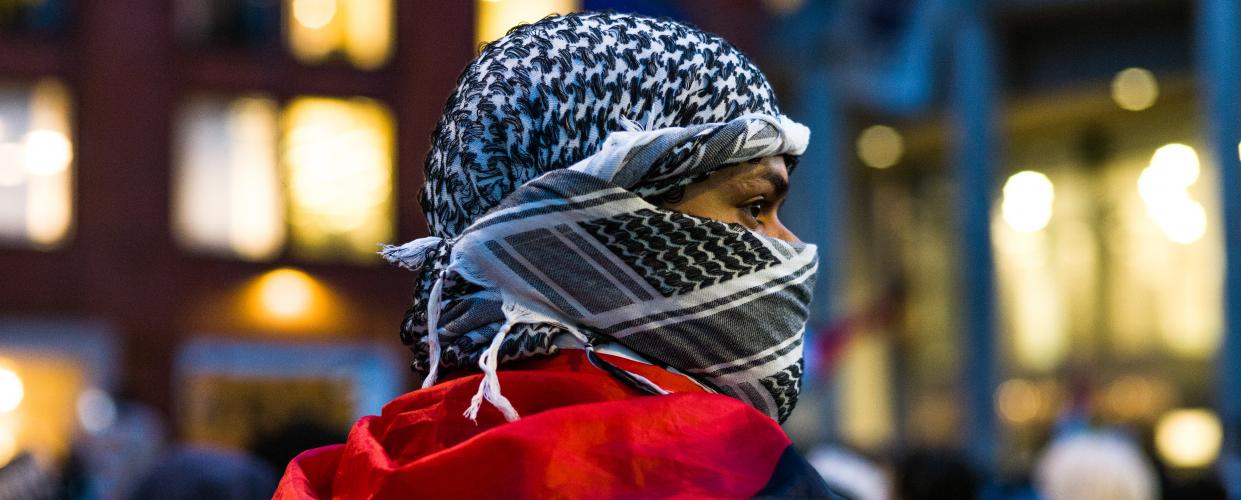
16/05/2024 إنكليزي

15/05/2024 عربي

15/05/2024 إنكليزي

10/05/2024 إنكليزي

10/05/2024 عربي

10/05/2024 إنكليزي

09/05/2024 عربي

08/05/2024 عربي


Since Wednesday, April 17, multiple Gaza solidarity encampments have been assembled across New York City campuses by anti-genocide student protesters. Columbia University and Barnard College were the first New York City academic institutions to set up camp, with New York University (NYU), The New School, the Fashion Institute of Technology (FIT), and the City College of New York (CCNY) quickly following suit.
Learning from the Vietnam anti-war protests of the 1960s and 1970s, college students across the country are calling for a permanent ceasefire and a free Palestine by building “liberated zones” where peers and community members can engage in emancipatory dialogue. Students at Columbia’s encampment — who have faced some of the harshest repression within NYC — have reclaimed their institution as “The People’s (Popular) University for Palestine.” Students declared the space as a place that centers educational opportunity on “Gaza, Palestine, and the struggle for liberation everywhere.”
Each respective chapter of Students for Justice in Palestine (SJP) has created a list of demands and stands firmly on the premise that, until all demands are met, they will not cease occupying their universities. The three demands laid out by Columbia SJP are similar to what most student protesters are asking for: that the university administration discloses the institution’s financial investments, divest from Israel and grant amnesty for all students and faculty members defending Gaza.
SJP has been the primary group behind organizing these encampments, but hundreds of unaffiliated students, faculty, and community members have come out to support the movement. Every single one of these campus protests has been met with police brutality, having their encampments raided and tents taken away, with some universities going as far as suspending students and evicting them from university-owned housing. Still, in the face of administration disapproval, Columbia students passed a referendum to divest from Israel, a further demonstration of where the vast majority of the student body stands.
An SJP organizer at NYU — who wished to remain anonymous for safety purposes — reflected on her experience protesting for Palestine. After being arrested, she explained how the Israeli Occupation Forces-trained NYPD raided NYU’s encampment during the Maghrib prayer on Monday, April 22. NYU president Linda Mills told students that the NYPD was deployed to “prevent harm,” but this SJP member emphasized that the NYPD created the harm. As the designated medic, she stated that no violence was present, nor did anyone need medical attention prior to the NYPD’s rampage.
The night ended with over 40 students and faculty members being arrested. She recalls that the next day, NYU began building an “apartheid wall” at Gould Plaza, where the encampment had been. Ironically, she shares that NYU’s slogan is “a campus without walls.”
During her interview with Palestine Square, this organizer asked: “How are we trespassers on our own campus, where we pay tuition?” She went on to explain how this is just a minuscule example of how Palestinians and their allies are being robbed of their right to exist on their land. “NYU is complicit in colonization and white supremacy.” The actions taken by the administration are worldwide tools of colonialism.
Regardless of the difficulties, student protesters have faced at NYU, she says that “it’s an honor to fight for Palestine.” She assures Palestine Square that NYU students will not stop until their four demands are met, one of which is unique to NYU and involves shutting down NYU’s Tel Aviv campus.
The New York-based organizer insists that student protesters must refuse to let their message and demands be co-opted by the press in light of false, racist claims from Western media claiming that these protests are “antisemitic” when they are, in fact, in opposition to genocide and Zionism. “This media framing won’t be allowed because we’re taking back the narrative and centering Gaza and Palestine,” she adds.
“Many people are wondering why we would miss out on our education to sleep on the concrete in the cold. It’s because the education provided in the encampment was one where we received more humanity, community, and freedom of thought in 15 hours than I received in five years of attending this so-called ‘liberal’ institution. As we help in the movement to free Palestine, Palestine is also freeing us.”
Upon visiting the protests at both Columbia and NYU, two major similarities can be found across campuses: the mass levels of community support and the intimidation and fear-mongering coming from university administration and the NYPD at the behest of the Israeli lobby.
Outside of the Columbia encampment, people stop by every so often with food, water, and other necessities to support those who are staging the sit-in. The same solidarity and coordinated action was on full display at NYU on its first day. Some of these encampments have garnered so much support that they’ve been able to forward donations along to Gaza mutual aid funds, such as SJP at The New School has done.
These student protests have spread across North America and Europe, adding intensity to the global Palestinian liberation movement. Even after more than 200 days of genocide, it is clear that Palestine won’t be forgotten. With steadfastness, students continue to place Gaza at the heart of this movement.
Photo by Shedrick Pelt at New York University on April 22.








